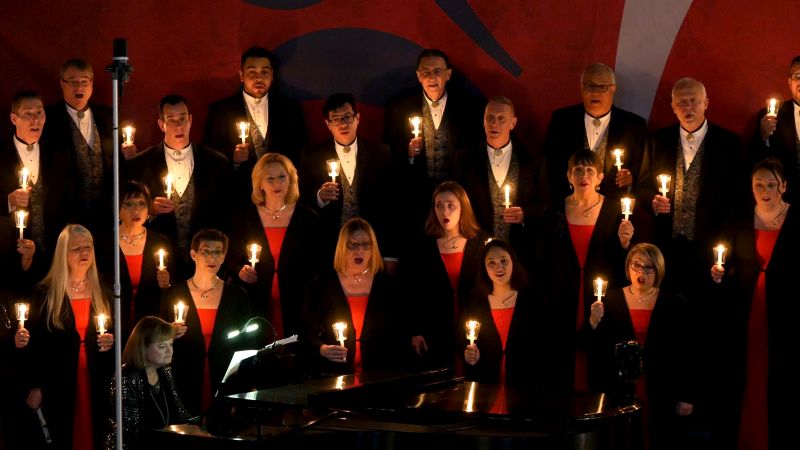Choral Review
Sacramento Master Singers
A Master Singers Christmas - December 20, 2018
This was Sacramento Master Singers’ (SMS) last of 5 Christmas concerts in this season, the only one to be held at Harris Center, an excellent venue for a choral concert — or any performance, for that matter. I arrived nearly a half-hour early, and I spent some time reading the program. When people come to a choral concert, especially if they’re seated just a few minutes before the concert begins, their focus is on chatting with companions, checking their phones, and perhaps glancing at the program. And the more pages there are in the program book, the less likely they are to look through it carefully. That would have been unfortunate for this concert, because there were informative, even fascinating details about each song. Take a look now (link below), and you’ll see what I mean. I was glad to have pored over the program before the concert: what I read enhanced my appreciation of each piece. Had I waited to check the description of any of the music, I would have found the theater too dark to read.
The excellent commentary in the program makes me self-conscious about writing a review of this concert. My background knowledge and even my experience with choral music is limited. Therefore my role, as I see it, is to record my impressions of the flow of the concert as an observant and somewhat informed audience member. Hopefully that has value as feedback to the chorus, as a pleasant reminder to the other audience members of what they experienced, and perhaps as encouragement to others to attend this group’s future concerts.
At 7:00 the house lights dimmed, and chorus members Matt Metcalf and
Barbara Celli came out to welcome the audience, noting that this was
Sacramento Master Singers’ 35th year of presenting “world class choral
music” (not an exaggeration, based on what I subsequently heard).
They also asked us to refrain from applause during the first candlelight
set. Then, with the house lights brought down fully, the singing of Mack
Wilberg’s “O Magnum Mysterium” began from the balcony.
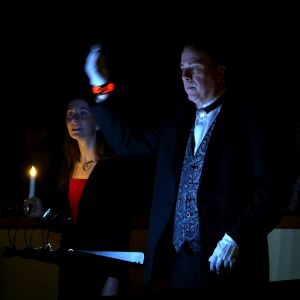 Artistic
Director and Conductor Ralph Hughes, with white gloves and a lighted red
wristband, was leading the singing of 16 chorus members who were
standing behind him and holding electric candles. Simultaneously, the
remaining members of the chorus — each holding a candle — slowly moved
into positions surrounding the main body of the audience, carrying their
part of this song. I couldn’t call the piece melodic; it even seemed
somber to me at first. The program notes describe it as a “meditation,”
and indeed, I eventually found it thought-provoking or perhaps even
reverie-inducing.
Artistic
Director and Conductor Ralph Hughes, with white gloves and a lighted red
wristband, was leading the singing of 16 chorus members who were
standing behind him and holding electric candles. Simultaneously, the
remaining members of the chorus — each holding a candle — slowly moved
into positions surrounding the main body of the audience, carrying their
part of this song. I couldn’t call the piece melodic; it even seemed
somber to me at first. The program notes describe it as a “meditation,”
and indeed, I eventually found it thought-provoking or perhaps even
reverie-inducing.
(Click here to open the concert program in a new window.)
The tolling of a handbell marked the transition to the next piece (and kept the audience from any thought of applauding). “Jerusalem” was performed by the women only — a cappella, as was most of the music in this “candlelight set.” Moments into this selection, it was evident to all of us that this was going to be unlike any Christmas concert we had ever experienced. For one thing, as the piece proceeded, I became aware that the women, who were still surrounding us, were moving during sections of the music — not to reach a particular destination, but encircling us. And in the moving sections, they were singing in an “aleatory” fashion. This means that individual singers began their assigned part when they felt like it. The result was a beautiful cacophony — a choral effect that I bet few audience members had experienced before. These aleatory segments occurred while the women were moving. In their new position they resumed the organized flow of the music, highlighted by an incidental solo from one of the 3 designated soloists.
Another tolling of a handbell, and the men of the chorus began singing (without accompaniment) “Adeste Fideles” — in Latin and with small, unexpected changes in timing and in the vocal line. Then the women continued with the second verse — still in Latin. Next, in lieu of another verse, we got the first verse again, this time in 4-part harmony and in English, and I can’t adequately express how viscerally satisfying this was. But they weren’t through. A fourth verse (I believe it was the second verse in English) came with a vigorous piano accompaniment and a descant part. It was grand!
In “Jesus Christ the Apple Tree” I was taken by an interesting overlapping of the parts toward the end. I don’t have a name for this technique, but between the creative arrangements in this concert and innovative interpretations of the director, there was a freshness and interest in everything we heard. And that included the subsequent song, John Rutter’s “Christmas Lullaby.” But it was the beauty of this latter piece that was so striking. The excellent articulation of this chorus was particularly evident here, and in addition I observed in my notes that the song was “sung and directed with artistry.”
After the gentle “Christmas Lullaby,” the next selection, “True Light” was a shock — a pleasant one. It incorporated a gospel rendition of “This Little Light of Mine,” and the singing was aggressive, expressing a different kind of joy, and this song really rocked. If your foot wasn’t tapping while you listened, your foot must have been stuck to the floor. And the excitement as the piece built to a conclusion was deliciously intense.
|
|
At this point in the concert, Hughes blew on his hand as a signal for the singers to turn off their candles. Finally unrestrained, we in the audience erupted in applause for the diverse, extraordinary set of music that we had just been treated to. Meanwhile among the chorus members, candles were collected and scores were passed out. That emphasized the fact that the first 6 pieces in the concert had been performed from memory — and much of what was to come was also memorized. I’ve seen this before, and I continue to be amazed by the memorization abilities of this group.
The joyful spirit of “True Light” continued in “Gaudete.” I found myself writing single words to describe the singing I was hearing throughout this program, and the word I wrote for this song was “limber” to describe how these people handled this rhythmic arrangement. What I felt about this piece, I felt about the whole concert: there was such variety in emotion and in vocal technique, that an audience member would be transfixed taking it all in.
My word for the next selection, “Shepherd’s Pipe Carol,” was “crisp.” That was the kind of singing that allowed the words of this story-in-a-song to come through. Beyond that, I was struck again, as I had been throughout this concert, by the sheer quality of the singing — the precision and clarity of the tone, the richness of the harmony — so easy to listen to. And then there was the other excellence in this performance: the playing of accompanist, Heidi Van Regenmorter. There were so many times in this concert when her playing was nothing short of brilliant.
Eric Whitacre is apparently a favorite composer of this chorus, as he is of so many choruses these days, and I felt that I could sense the pleasure director and chorus took in presenting Whitacre’s “Lux Nova.” My word for this performance was “precision.” As the music blossomed, I couldn’t help but feel that there was more going on than I could possibly fathom. Yet it was fun for me to speculate about the meaning of the intense passion in the piece and formulate my own story of what it was all about.
One of the many ways in which SMS excels is in their presentation of music from other cultures. The Spanish of “Riu, Riu, Chiu” was an excellent example of this. The singers put their scores down and with just the accompaniment of a tambourine, they delivered this song with extraordinary rhythmic energy. And the rhythm was accentuated by clapping routines that were unbelievably complex, bringing smiles to the faces of the singers — and, I’ll wager, to everyone in the audience. It really felt like a celebration.
At this point Hughes introduced the intermission, suggesting that we use some of the time to “warm up” because we would be called on to sing in the next half of the concert.
We had seen a bit of “choralography” in “Riu, Riu, Chiu,” and there was more in “Sorida,” the first selection after intermission. With a trio of women singers down stage and 5 percussionists, the rest of the chorus filed onto the stage singing and walking in step to the beat of the music. Once on the risers, they began swaying, and with all the smiles, it felt like the celebration of “Riu, Riu, Chiu” had just moved to somewhere in Africa.
 Now
the men of the chorus exited, and Assistant Conductor Emily Carbrey took
over the directing. “Sing We Now of Christmas” started alternating
between French and English, and with the energy and excitement building,
we got what seemed to me like a demonstration of vocal gymnastics along
with great expressiveness. There were piano gymnastics, too. The
accompaniment was so intense that Van Regenmorter required a page
turner, and what we heard from her sounded to me like the work of a
piano virtuoso.
Now
the men of the chorus exited, and Assistant Conductor Emily Carbrey took
over the directing. “Sing We Now of Christmas” started alternating
between French and English, and with the energy and excitement building,
we got what seemed to me like a demonstration of vocal gymnastics along
with great expressiveness. There were piano gymnastics, too. The
accompaniment was so intense that Van Regenmorter required a page
turner, and what we heard from her sounded to me like the work of a
piano virtuoso.
Carbrey continued her precise, animated directing in the next piece as the women performed “Now Let Me Fly.” It was identified in the program as a “traditional spiritual,” but as the singing began, it seemed too refined and smooth for a spiritual. That was temporary, though, because as the melody turned to that of “I’ll Fly Away,” a strong pulse took over, and we had another audience-pleasing toe-tapper.
At this point in the concert, I began to understand what I had been witnessing. We had been served an extraordinary variety of music, a choral holiday dinner with a great variety of dishes. But there was more to the variety than the different melodies, rhythms, and subjects. With practically every song there was a different singing style — or more precisely many singing styles in each song. I developed a respect for the enormous amount of thought that must have gone into how each detail of each musical section was presented. Each piece felt crafted; it was all so fresh.
The singalong (“Christmas Medley”) that came next was distinctly different from the singalongs I’ve experienced at other recent choral concerts. For one thing, the SMS chorus performed some verses alone, and the arrangement of the whole piece was interesting. Then a bit of clowning around in the “Jingle Bells” section added to the fun.
Next the women left the stage and the men gave a moving, stimulating a cappella performance of “What Child Is This?” Listening to them, the thought occurred to me that this is as fine a men’s chorus as I’ve heard in recent years. You could take these guys on the road, and they would dazzle audiences near and far.
Watching and listening to a group that was truly delivering “world class choral music” frequently got me trying to analyze what I was observing. It seems to me that singing in SMS requires “musical intelligence,” and I’d define that as singing with understanding and constant alertness. You have to be ready for whatever’s next — in the notes, in the diction, in the rhythm, in the expression — because “what’s next” will so often be nothing like what you’ve been doing.
Over the years, many singers and singing groups have recorded “The Little Drummer Boy,” but the version I, and maybe you, remember best is the one that got decades of radio play — the Harry Simeone arrangement performed by Fred Waring and The Pennsylvanians. Well, forget it. The Patrick Rose version that SMS performed tonight was nothing like that old standard. For a start, this is the most elaborate arrangement I’ve heard, unpredictable and full of dissonance. It was almost like the arranger was trying to trick the singers and set traps for them. They weren’t fooled, of course. Their concentration was amazing, and their performance of this piece was unforgettable — a tour de force to my mind.
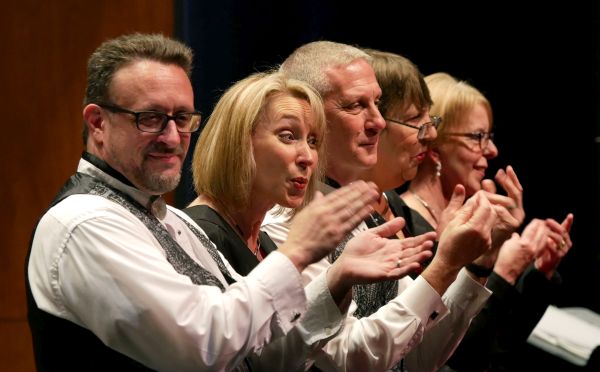 “White
Winter Hymnal” had the air of a production. Two sets of 5 stools each
were set up on the stage and occupied by singers. Five more singers sat
on the edge of the stage, and Hughes observed that “people in the front
row are suddenly scared.” This all made sense when I realized that SMS
was performing the Pentatonix arrangement of this piece, made popular by
its inclusion on their 2014 Christmas album. Their performance featured
elaborate “body percussion,” which was to be part of this performance.
The singing began with everyone, including those on the risers, patting
their body with their right arm extended across their chest. As the song
progressed, the body percussion became more elaborate, with finger
snapping and knee slapping, occasionally including the person to one’s
right or left. Hughes refrained from trying to direct all this, watching
the performance from stage left. The song itself was simple and pleasant
listening, but as the slaps and snaps became more complicated, I found
myself asking “How could they do this while singing?” I don’t want to
take anything away from an interesting, fun performance, but later I
found an instructional video for the body percussion of “White Winter
Hymnal” on YouTube.
“White
Winter Hymnal” had the air of a production. Two sets of 5 stools each
were set up on the stage and occupied by singers. Five more singers sat
on the edge of the stage, and Hughes observed that “people in the front
row are suddenly scared.” This all made sense when I realized that SMS
was performing the Pentatonix arrangement of this piece, made popular by
its inclusion on their 2014 Christmas album. Their performance featured
elaborate “body percussion,” which was to be part of this performance.
The singing began with everyone, including those on the risers, patting
their body with their right arm extended across their chest. As the song
progressed, the body percussion became more elaborate, with finger
snapping and knee slapping, occasionally including the person to one’s
right or left. Hughes refrained from trying to direct all this, watching
the performance from stage left. The song itself was simple and pleasant
listening, but as the slaps and snaps became more complicated, I found
myself asking “How could they do this while singing?” I don’t want to
take anything away from an interesting, fun performance, but later I
found an instructional video for the body percussion of “White Winter
Hymnal” on YouTube.
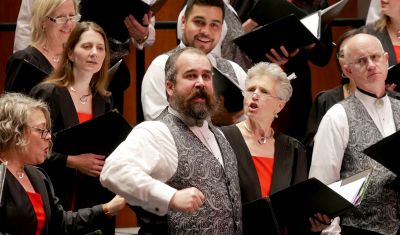 In
introducing the “12 Days of Christmas,” Hughes cautioned us: “Please do
not sing along.” It would have been impossible anyway because they were
about to perform a choral adaptation of the hilarious arrangement
popularized by the a cappella group, Straight No Chaser. It began with
confusion about which of the 12 days we’re on, followed by snatches of
other carols. This brought a constant stream of laughter from the
audience. Then the music for the random lyrics was taken over by the
sounds of the 1980s song “Africa” that was popularized by the group Toto,
and then given new life in choral circles by Perpetuum Jazzile from
Slovenia. This took the brilliant humor to a new level, and the audience
roared its approval when the piece concluded.
In
introducing the “12 Days of Christmas,” Hughes cautioned us: “Please do
not sing along.” It would have been impossible anyway because they were
about to perform a choral adaptation of the hilarious arrangement
popularized by the a cappella group, Straight No Chaser. It began with
confusion about which of the 12 days we’re on, followed by snatches of
other carols. This brought a constant stream of laughter from the
audience. Then the music for the random lyrics was taken over by the
sounds of the 1980s song “Africa” that was popularized by the group Toto,
and then given new life in choral circles by Perpetuum Jazzile from
Slovenia. This took the brilliant humor to a new level, and the audience
roared its approval when the piece concluded.
The next two selections were characterized by a 4-hand piano
accompaniment, with Ralph Hughes joining Heidi Van Regenmorter. From the
singers we got a rendition of “Have Yourself a Merry Little Christmas”
that was full of spirit and precisely channeled energy. But I have to
add sympathy for Van Regenmorter, who was playing in the upper end of
the keyboard. Somewhere above the piano was a duct pouring out air and
blowing the score that she and Hughes were playing from. Every few
seconds she had to reach up to straighten the music.
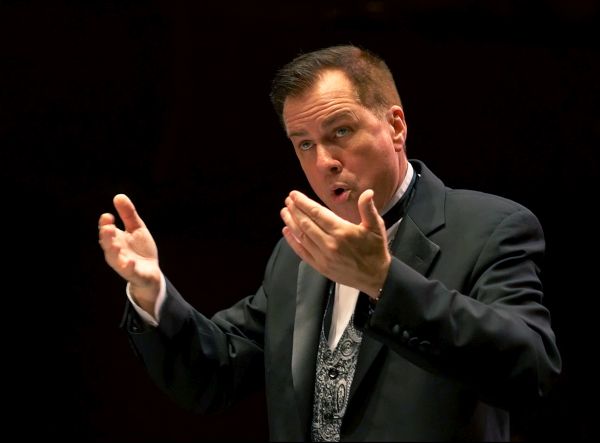 With
singers and fellow pianist depending on her, she dealt with this
annoyance without affecting her playing. In my book that made her
performance nothing short of heroic. Then the pianists switched places
and accompanied “Fum, Fum, Fum” in a bright, innovative arrangement that
the singers built to a grand, concert-climaxing conclusion.
With
singers and fellow pianist depending on her, she dealt with this
annoyance without affecting her playing. In my book that made her
performance nothing short of heroic. Then the pianists switched places
and accompanied “Fum, Fum, Fum” in a bright, innovative arrangement that
the singers built to a grand, concert-climaxing conclusion.
That wasn’t all, of course. For over 30 years, Sacramento Master Singers have ended their Christmas concerts with the same music, “Peace, Peace” by Rick and Sylvia Powell. While Hughes explained this tradition to us, the singers moved out to surround the audience. The house lights went up, and, as they have done for so many years, the Master Singers delivered this gentle, inspiring song — from memory and while signing the words in American Sign Language. As I watched, the smiles of the singers convinced me that the feeling they were conveying was genuine. It was their tradition, and the meaning of it was something they wanted to share with the audience. Then without interruption, “Peace, Peace” melted into “Silent Night.” The singers continued their signing, and most of us in the audience sang along, sharing the good feelings that had blossomed in this thoughtful end to a concert that truly was full of “world class choral music” — performed by a world class chorus.
Pictures courtesy of VideoMelody.
Dick Frantzreb is past editor of the Sacramento Choral Calendar and co-founder and past President of the Sacramento Valley Choral Coalition. He currently edits the Placer Performance Calendar and the new Capital Region Performance Gallery. He has been loving live performances in the greater Sacramento area and writing about them since 2012.
